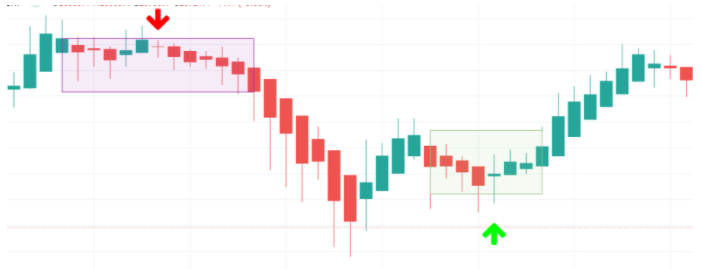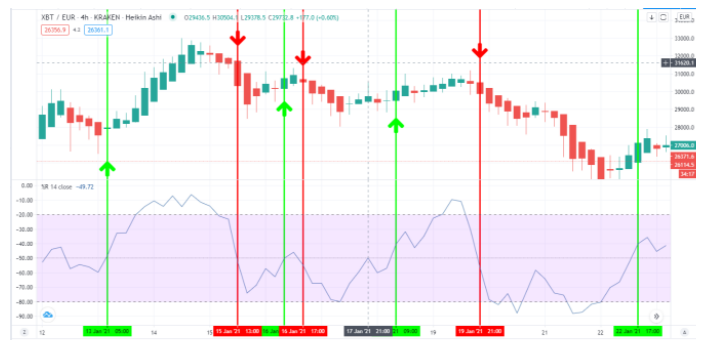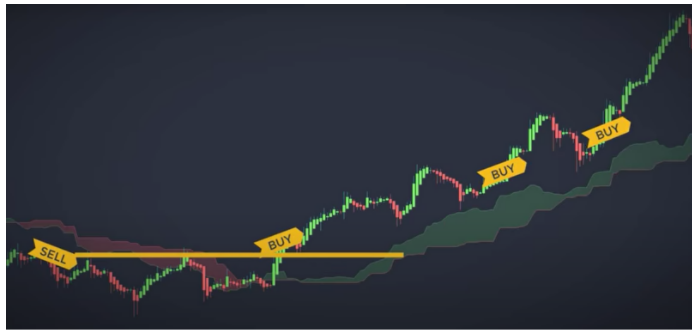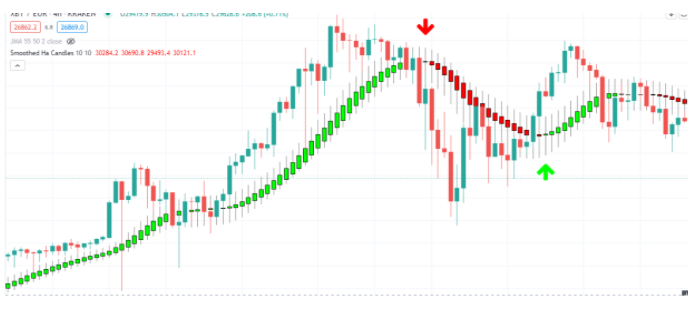Heikin Ashi is a chart modification that transforms how candles are presented so a trader can see a trend more clearly. Noise reduction is the primary purpose of HA however strategies that use it are many. Our following example of using Ha does not mix anything else just pure HA trading. Of course, you can improve on it with rules and other indicators, still, we leave that up to you. HA interpretation is subjective and here is how we like to use it.
Reading Heikin Ashi candles is similar to the regular ones except these have clear patterns. HA candles color tell the trend however, they also have a wick that actually gives info about the trend momentum. HA candle with a wick on one side is a good indication a trend will move on. Uptrend candles have usually green-colored bodies if not customized and have a wick above. The opposite is for red bearish trend candles. Once the trend starts to slow or consolidate wicks on both sides will appear. A good signal a trend is over is two or more HA candles resembling a Doji as shown in the next picture:

Big candles with a long wick on one side is a strong indication of a good trend momentum, however, pay attention to the sequence. HA filters noise so expect to see more series of candles of the same color. If you see small bodies with wicks on both sides then this is definitely a flat market you do not want to be trading, especially if you cannot count more than 2 same-colored bodies in a row. When building a system with HA you can set this up as a rule to avoid losers.
Our HA strategy incorporates one more aspect of trading which is not obvious yet commonly used by experienced traders. It is the higher time frame alignment. If you are trading the daily chart, then consider weekly and monthly, two higher time frames. When you see a good momentum HA candle with one wick on all three time frames, this is a high probability trade. Trends tend to keep trending, some are steep and fast others are slow and long with many corrections but generally, trend following strategies are considered the best. Aligning all three higher time frames you consider trends that are older and bigger than what you see on the lower timeframe. Like this, we add up all probabilities from these trends into one. Applying the higher timeframe alignment rule implies we will have fewer signals to trade but these trades will have a better win rate and better yield. A rule that manages to eliminate 2 losers and one winner is a good one and makes the P/L line look much better.
If you need more confirmations a trend is emerging you could incorporate a rule to enter a trade only if two consecutive strong trend HA candles appear. Test this rule out and if you have eliminated some fake signals, try with 3. Making too many short-lived trades could also be an issue. Consider a similar exit rule in such scenarios by waiting for two or three candles of the opposite color. It is important to keep trying new things on the same backtesting sample to know if you have improved the strategy. Also, try to sample various currency pairs for the same period and aggregately see if improvements are made.
The above strategy is pure HA that produces good results and is one of the best practices on how to use HA. Of course, it could be better if we add more tools to it, but not any tool. Williams %R is one indicator that we like to use differently than intended. For example, we set the Willimas %R to 14 periods on a daily timeframe or you can go lower time frames, it will still work great. Whenever we see the line crossing the 50 value, we see it as an additional confirmation of a trend. In combination with the HA, this strategy gives great results. Here is the picture of a few trades in a difficult market environment:

Even though market conditions are not so favorable, we managed to have only one loser, can you guess which one?
Ichimoku is a trend following composite indicators but could it be improved by using another Japanese tool like the HA? We will use only the Kumo cloud and it will serve us as the trade direction filter. We will use the default settings. Whenever the HA candle pierces the cloud we only trade that direction trades. So if the price is below the Kumo we only sell and if above we only buy. Here is how it looks like:

So we avoid trading corrections since they are against the trend and likely losers. However, we notice the first trades that break out of the Kumo are not the best ones and these play the biggest negative balance changer. We can incorporate a simple rule here to avoid this – skip the first trade signal and enter only consecutive obeying the Kumo direction rule. We still want to see HA candles with only one wick and not too far from the Kumo to confirm it is a trend continuation.
The cons of the HA is that it eliminates the information from the classic Japanese candlesticks, such as the high and lows. This means HA cannot be used for Price Action, one of the most used analysis methods. Smoothed HA does not modify how you see the chart candles but instead plots a moving average-like line. The result is that you can use both styles in one strategy:

Smoothed HA acts more as a moving average that is bast used as the trade direction filter, like a regular MA, use it as trend exhaustion or reversal when the price breaks through it or use it to confirm trends with the candle color change. You get the idea there are many other interpretations but these are best practices. Smoothed HA intended to use it alongside Price Action patterns and lines. Lower settings of the indicator are used for scalping strategies and trailing stops, typical for these strategies is the 5,5 setting on both integrated MAs of the smoothed HA. 10 and 10 periods can serve as a general use trend following support line where price bounce off it to resume trending or signal an exit on price cross. 20, 20-period settings make Smoothed Heikin Ashi good for pullbacks during unstable trends. Forex is a place of choice for such settings. Longer periods are also good for “buy the dip” strategies but trends that extend for a long time typically found in stocks or indices.
Combining two Smoothed HA use is similar to the two moving averages however you can create different scenarios with the Smoothed HA bars and wicks. The most successful one is using the faster one for exits while the slower one is good for gauging trend direction and rebounds.
Our best trading practices in the next article will involve a very rare setup that consists of indicators that also measure an important market characteristic – volume. Customized yet simple, and very powerful for trend trading.
